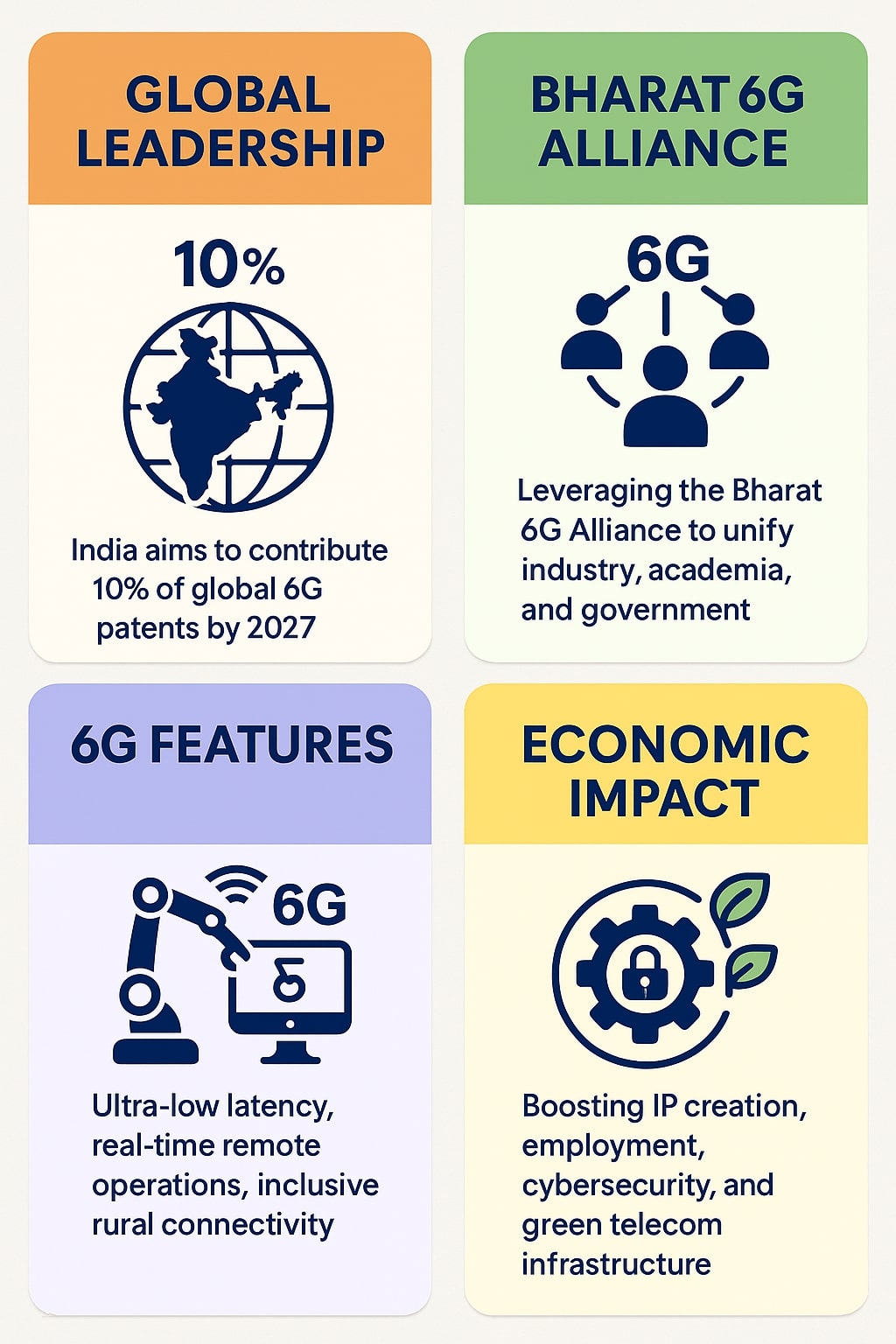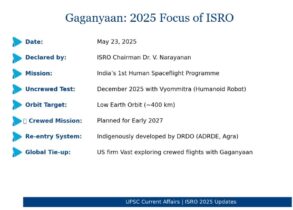India’s 6G Vision: Aiming for Global Leadership by 2027
India’s 6G Vision: Aiming for Global Leadership by 2027
On March 23, 2023, Prime Minister Narendra Modi unveiled a bold and forward-looking policy document titled the “Bharat 6G Vision document”, signalling India’s intent to emerge as a global leader in sixth-generation (6G) communication technologies by 2027. This announcement marked a crucial step in India’s technological trajectory, aiming not just for domestic advancement, but for international leadership in futuristic wireless communication. The Bharat 6G Vision sets ambitious goals for India’s role in shaping the future of the 6G network in world connectivity, with a focus on research and innovation.
What is 6G? Understanding the Next Leap in Communication
6G, or sixth-generation wireless technology, is expected to revolutionize digital infrastructure by building upon the foundation laid by 5G. Unlike its predecessor, which focused on faster internet and connectivity, 6G technology in India promises to introduce a hyper-connected, intelligent network ecosystem. Key features of 6G include:
- Ultra-High Speeds in 6G: Potential data transfer speeds of up to 1 terabit per second, enabling instantaneous downloads and seamless streaming of ultra-HD content.
- Sub-Millisecond Latency: A game-changer for sectors like autonomous transportation, remote robotic surgeries, and tactile internet.
- Global Coverage: Enhanced connectivity through the integration of terrestrial networks with satellites, ensuring uninterrupted communication even in remote and underdeveloped regions.
- Support for Emerging Technologies: Such as immersive augmented reality, holographic communications, and AI-powered applications in real time, paving the way for advancements in the metaverse and digital economy.
The Bharat 6G Vision: India’s Strategic Roadmap
The Bharat 6G Vision document lays out a clear two-phase roadmap, addressing the question of when is 6G available in India:
Phase I (2023–2025): Research and Development
- Exploratory Research: India is investing heavily in R&D across cutting-edge areas like terahertz (THz) communication, quantum networks, AI-optimized protocols, and new waveforms. THz communication, in particular, is a key focus area for 6G technology in India.
- Proof-of-Concept Trials: Prototype testing, pilot projects, and academic-industry collaboration aim to validate innovations and establish global patents. This includes setting up 6G testbeds for rigorous experimentation.
Phase II (2025–2030): Deployment and Commercialization
- Standardization and Policy Alignment: India aims to play a pivotal role in defining global 6G standards by working with the International Telecommunication Union (ITU) and contributing to the IMT 2030 framework.
- Infrastructure Rollout: Nationwide 6G backbone development, with special focus on rural integration and urban densification.
- Commercial Launch: Seamless transition to 6G services across sectors—public safety, e-governance, smart cities, and enterprise-grade connectivity.
The 6G in India timeline suggests a potential 6G release date in India around 2030, aligning with global projections for 6G technology deployment. This timeline also addresses the question of the 6G launch date globally, as India aims to be among the first countries to deploy this technology.
Institutional Mechanisms Supporting 6G in India
India’s 6G mission is backed by robust institutional architecture:
- Technology Innovation Group on 6G (TIG-6G)
Set up by the Department of Telecommunications (DoT), TIG-6G identifies key research areas, facilitates interdisciplinary collaboration, and advises on national policy direction.
- Bharat 6G Alliance (B6GA)
This public-private partnership platform brings together academic institutions, telecom industries, R&D labs, and startups to foster an innovation-driven 6G ecosystem. B6GA also supports India’s 6G patent pool and aligns efforts with international benchmarks.
India’s Global Strategy: From Consumer to Contributor
India aims to shift its global position from being a net consumer of telecom technologies to a net exporter and contributor, particularly in the area of intellectual property:
- Targeting 10% of Global 6G Patents: By 2027, India aspires to contribute 10% of all global 6G patents, as per Telecom Minister Jyotiraditya Scindia.
- Strategic International Collaborations: India is actively engaging with Japan, Finland, South Korea, and the United States for joint research, spectrum policy dialogues, and pilot trials.
- ITU Engagement: Indian technocrats and policymakers are involved in ITU’s working groups to shape the technical standards and frequency bands essential for 6G.
This strategy positions India for 6G global leadership, aiming to be among the first countries to have a 6G network. As the world wonders which country has 6G network capabilities, India is working to ensure it’s at the forefront of this technological revolution.
Why 6G Matters for India: Economic and Social Impact
1. Economic Transformation
According to estimates, successful 6G implementation could contribute up to $1 trillion to India’s GDP by 2035, by empowering high-tech industries, boosting productivity, and enabling new-age entrepreneurship. The 6G technology is expected to be a cornerstone of the future digital economy.
2. Digital Equity
With its rural-first approach, India’s 6G strategy emphasizes digital inclusion, ensuring that high-speed, low-cost internet access is no longer a luxury but a right, especially in Tier-II and Tier-III regions. Digital equity in 6G is a key focus, aiming to bridge the digital divide across the nation.
3. Technological Innovation
6G will drive transformative changes across sectors:
- Healthcare Applications: Real-time telemedicine and robotic surgeries, revolutionizing medical care.
- Education: 3D virtual classrooms and immersive learning experiences.
- Smart Agriculture: AI-powered monitoring and satellite-linked crop analytics for improved yields.
- Manufacturing: Industry 4.0 automation with zero-latency communication.
- Disaster Management: Enhanced early warning systems and rapid response capabilities.
- Sustainability: Efficient resource management and environmental monitoring.
Challenges and Future Prospects
While the ambition is commendable, India must overcome several obstacles:
- Spectrum Planning: Harmonizing global frequency allocation while reserving space for domestic innovation.
- Infrastructure Upgradation: Current 4G/5G infrastructure must be scaled up to support ultra-dense, intelligent 6G networks.
- Skill Gaps: A massive push is needed to train engineers and researchers in nanotech, AI, blockchain, and edge computing.
- Security Concerns: Cybersecurity, data integrity, and quantum-safe encryption must be embedded into 6G from the outset.
The 6G future prospects for India are promising, with focus areas including:
- Volumetric Connectivity: Enabling high-quality communication in three-dimensional spaces.
- Ubiquitous Connectivity: Ensuring seamless integration of terrestrial, aerial, and satellite networks.
- AI-Powered Networks: Leveraging artificial intelligence for network optimization and management.
- Indigenous Development: Promoting homegrown solutions and technologies, including the use of “६जी” (Hindi for 6G) in local communications to enhance cultural relevance and adoption.
Conclusion: The 6G Era Is India’s Opportunity
The Bharat 6G Vision is not just about technological supremacy—it’s about securing digital sovereignty, closing the global digital divide, and empowering the next billion users. As the world gears up for this next wireless revolution, India’s focus on affordability, inclusivity, and innovation could well define the global narrative of 6G technology.
By 2027, if executed with determination and foresight, India could emerge not just as a participant, but a pioneer in shaping the future of global connectivity. The Bharat 6G project represents a significant step towards establishing India as a key player in the 6G network world, with the potential to influence the global 6G launch date and set new standards in AI-integrated networks and advanced communication technologies like THz communication.
As research and innovation continue to drive the development of 6G technology in India, the country is poised to make significant contributions to the global telecommunications landscape. The use of “६जी” (Hindi for 6G) in local communications further underscores India’s commitment to making this advanced technology accessible and relevant to its diverse population. With the Bharat 6G Vision document as its guide, India is well-positioned to become a leader in the next generation of wireless technology.








